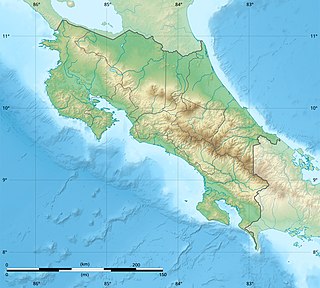
Costa Rica is located on the Central American Isthmus, surrounding the point 10° north of the equator and 84° west of the prime meridian. It has 212 km of Caribbean Sea coastline and 1,016 on the North Pacific Ocean.

Mount Chirripó is the highest mountain in Costa Rica, with an elevation of 3,821 meters. It is part of the Cordillera de Talamanca, and the range's highest point. It is located in Chirripó National Park and is noted for its ecological wealth. The mountain was named "Chirripo", meaning "land of eternal waters", by indigenous Costa Ricans because there are many lakes and streams around the mountain. The high peaks in Chirripó National Park and La Amistad International Park host important areas of Talamancan montane forest and Costa Rican Páramo with high endemism and extremely high biodiversity. The peaks of these mountains constitute sky islands for many species of plants and animals. Snow has not fallen on the peak in the past 100 years or so, according to the University of Costa Rica, but hail is sometimes reported.

The wildlife of Costa Rica comprises all naturally occurring animals, fungi and plants that reside in this Central American country. Costa Rica supports an enormous variety of wildlife, due in large part to its geographic position between North and South America, its neotropical climate, and its wide variety of habitats. Costa Rica is home to more than 500,000 species, which represent nearly 5% of the species estimated worldwide, making Costa Rica one of the 20 countries with the highest biodiversity in the world. Of these 500,000 species, a little more than 300,000 are insects.

Tapantí - Cerro de la Muerte Massif National Park,, is a National Park in the Central Conservation Area of Costa Rica located on the edge of the Talamanca Range, near Cartago. It protects forests to the north of Chirripó National Park, and also contains part of the Orosí River. The area known as Cerro de la Muerte Massif was added to the park on January 14, 2000.

The Cordillera de Talamanca is a mountain range that lies in the southeast half of Costa Rica and the far west of Panama. Much of the range and the area around it is included in La Amistad International Park, which also is shared between the two countries.
Talamanca is a canton in the Limón province of Costa Rica. The head city is Bribri, located in Bratsi district.

The Talamancan montane forests ecoregion, in the tropical moist broadleaf forest biome, are in montane Costa Rica and western Panama in Central America.
Cerro Kamuk is a mountain in the Cordillera de Talamanca, in La Amistad International Park, in eastern Costa Rica, close to the border with Panama. It rises to 3,549 metres (11,644 ft) above sea level. It is one of the highest mountains in Central America. Indigenous peoples of the area include the Bribris and Cabecar. The area protected comprised four national parks clustered together that became La Amistad Biosphere Reserve. UNESCO declared it a natural World Heritage Site in 1983. It is part of the Mesoamerican Biological Corridor, UNESCO's project shared by eight Central American countries to help protect the remaining pristine mountain forest and wildlife of Central America.

The Costa Rican páramo, also known as the Talamanca páramo, is a natural region of montane grassland and shrubland of Costa Rica and western Panama.
Isthmohyla calypsa is a species of frogs in the family Hylidae. It is known from the southern Cordillera de Talamanca in Costa Rica, Cerro Pando in Costa Rica and Panama, and the Pacific slope in southwestern Panama. It appears to now be extirpated from Costa Rica. Prior to its description in 1996, this species was confused with Isthmohyla lancasteri, a species now known from lower altitudes only.
Pristimantis altae, also known as mountain robber frog, is a species of rain frog in the family Strabomantidae with a bright coral-coloured groin. It is found in Costa Rica and Panama.
The crater salamander, also known as the marbled crater salamander, is a species of salamander in the family Plethodontidae. It is endemic to Costa Rica and Panama. Its natural habitat is subtropical, high-altitude moist montane forests. It has a small area of distribution and is threatened by habitat loss therein.
Brame's climbing salamander is a species of salamander in the family Plethodontidae. It is found in Costa Rica and Panama, particularly the Pacific and Atlantic slopes of Cordillera de Talamanca and ranging to Cerro Pando, Chiriquí Province and Volcán Barú. Its natural habitat is subtropical or tropical moist lowland forests and has been recorded between 1,900 and 2,300 meters above sea level. It has not been commonly recorded so nothing is known about its population. No threats are known and its habitat is currently under protection by Las Tablas protected area and Reserva de la Biósfera de La Amistad.

The Cabécar are an indigenous group of the remote Talamanca region of eastern Costa Rica. They speak Cabécar, a language belonging to the Chibchan language family of the Isthmo-Colombian Area of lower Central America and northwestern Colombia. According to census data from the National Institute of Statistics and Census of Costa Rica, the Cabécar are the largest indigenous group in Costa Rica with a population of nearly 17,000.

The Isthmian–Pacific moist forests ecoregion covers the lowland tropical evergreen forests on the Pacific side of the central mountains of southern Costa Rica and western Panama. As the meeting zone between North and South American floral communities, the area is one of very high biodiversity. Much of the rainforest has, however, been cleared for subsistence agriculture and cattle grazing.

The Chiriquí fire salamander, known as "Salamandra de fuego chiricana" in native Spanish, is a species of salamander in the family Plethodontidae. It is found exclusively in Panama and is endemic to the western highlands of Chiriquí Province. Like many Central American endemic species, it is threatened by habitat loss.












